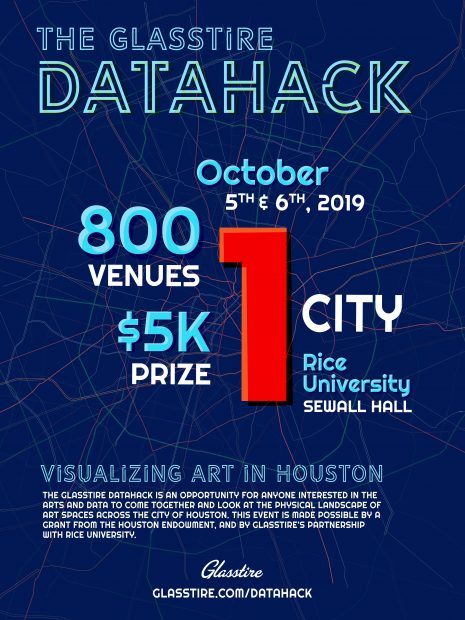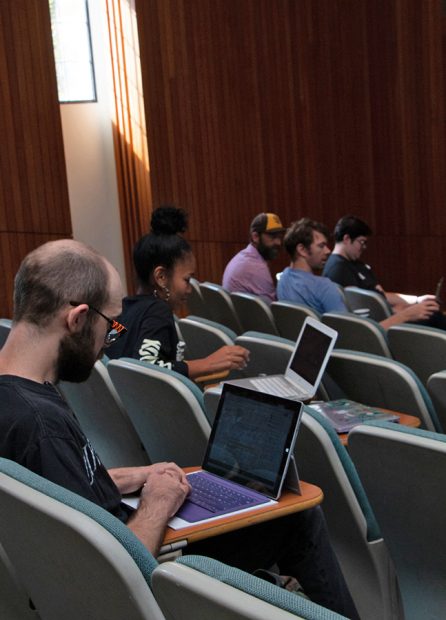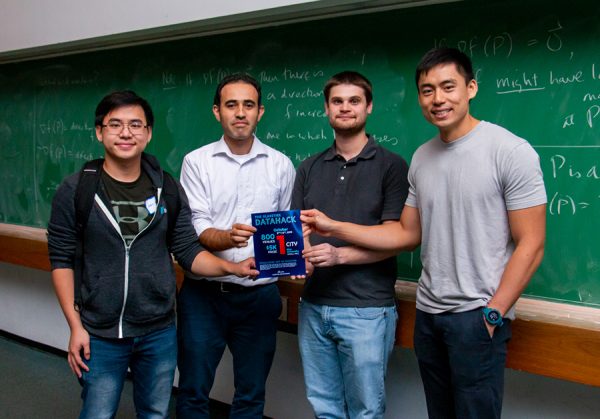
Last weekend, on October 5th and 6th, Glasstire hosted its first-ever DataHack, an event designed to provide an opportunity for people interested in the arts and data to come together and look at the landscape of art in the City of Houston.
The data released to participants of the DataHack included a set of data points that Glasstire has collected since 2007, comprised of all of the Houston-area art venues and events that have ever been published in our event listings.
Though we know our data set may not offer a complete view of the arts in Houston (as our event listings are manually entered by Glasstire staff based on event submissions, email newsletters, and events that our staff finds on social media and other sources), we at Glasstire believed that the data was important to explore, as it can provided an overview of the city’s visual art community.
Over the two days of the event, individual participants and teams worked on projects that interpreted and analyzed Glasstire’s data set. One project looked at the least-used venues in the City of Houston and those venues’ proximity to local community centers, with the ultimate goal of connecting artists with community resources. Another project aimed to calculate the overall impact of art venues and their events in Houston’s various zip codes and regions.

Participants at the Glasstire DataHack
One participant looked at the location of art events in Houston versus the location of companies hiring for science-related jobs in the city, with the conclusion that the geographic distribution of available science jobs and art venues isn’t so different. Another team, comprised of two artists, used Glasstire’s tagline “Go see some art” as a starting point, and looked for clusters of venues across the city.
Still another group went through Glasstire’s website, looking for art reviews of various venues represented in the dataset. They then compared Glasstire’s reviews to Yelp reviews and Tweets about individual venues, running all of the reviews and text through a sentiment analysis program, which is deigned to quantify the tone of a piece of writing. The group then used this analysis to compare the tones of the tweets, user-generated reviews, and Glasstire’s website.

A visualization by the winning project
The winning team at the DataHack, comprised of team members Huy Bui, Matthew Danielson, Pattrick Ly, and Ali Rasheed, created an accessible, interactive visualization of Glasstire’s data that broke down the number of events in the dataset by zip code, by year, by month, and by artist. You can see the winning project here.

The 2019 DataHack winners
Projects at the Glasstire DataHack were judged by a panel of three: Brian Piana, Chris Ertel, and Brian Rincon. The Glasstire DataHack was made possible by a grant from the Houston Endowment, and by Glasstire’s partnership with Rice University.
For more on the DataHack, please go here.



1 comment
Amazing work Glasstire! This is such a progressive, forward thinking project, and one especially relevant to the vast and far-flung arts districts of Houston (a strange and hard landscape to navigate for those new to the city). As the inner loop continues to gentrify and rent prices continue to rise at an increasing speed, and more arts organizations and curators turn their focus to roaming and nomadic models (such as Deasil Art, Bill Arning Exhibitions, Private Eye, Civic TV, and Flats), I’m interested to see how this data will look in the next five years (as well as how this roaming activity could be tracked).
Houston’s districts (whether art, music, business, etc) have always been decentralized in oddly distributed pockets throughout the city. Though we have seen the rise of many new “Cultural Districts” (in the early days born organically through the efforts of artists and arts organizers, and more recently out of the minds of real-estate developers), the city is today a harder place for smaller grassroots arts organizations to lay down roots than ever before. There is obviously a downside to this, but maybe there is an upside to it as well; there is something about the agility of roaming/nomadic arts organizations, and their ability to move throughout the city capitalizing on non-traditional spaces that may in fact create new pathways between the more established cultural districts, opening the whole city as fertile territory for culture to thrive. For this to happen though, we will need to see a greater recognition of this kind of nomadic arts organizing by the city, and by the art going public; at the moment I primarily see the die hard art goers at nomadic exhibition openings, that said I also see a good sized group of people at these nomadic exhibitions that I have never seen at other art openings and events, and so it makes me believe they have the potential to bring in new audiences (due to location, audience comfort level, etc.).
How can the city recognize the efforts of these non-truadional roaming arts spaces? How can the city make it easier for them to find donated spaces and create grants better suited to them (currently most HAA grants are not really geared to these types of arts orgs)? By encouraging these roaming arts organization’s work it seems to me that the city benefits greatly, as that they tend to happen in empty commercial spaces and homes in areas where cultural revitalization is needed (revitalization not gentrification, there is a difference, and perhaps the roaming model addresses this well by revitalizing culture in areas around the city, without the need to own real estate that could further gentrification).
It is a reality of the Houston landscape that for many smaller arts orgs and galleries the nomadic model will be necessary for sustainability, and increasingly so in the future as the inner loop gentrifies. It is also the reality that these grassroots arts orgs create a large part of the cultural programming throughout the the city (the data in the winning project seems to also point to this; the section covering “Number of Events Per Year” shows the up and down nature of arts programing here. It seems to me that the spikes in the graph correlate to times when there where many small arts organizations in town with their own rented locations, and the lows with times those same spaces either lost their locations or closed their doors due to rising rent).
So, it seems to me that a concerted effort by the city to help support the the growing number of nomadic art organizations is key because most of us doing nomadic organizing don’t see finding affordable space for permanent locations to be a sustainable viable reality in the future. I believe if we are to see the “Number of Events Per Year” graph level out at a consistently high point, it is these nomadic organizations and curators the city needs to find ways to support (support that will inevitably turn into greater cultural capital for the city, and may even offer us some way of disconnecting the traditional connection between art/cultural districts and gentrification).